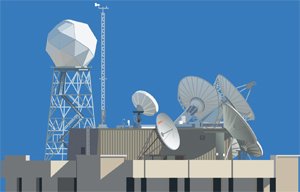 |
Director's NoteHank Revercomb |
My topic this month is the effect of the Federal budget on our work for NASA and NOAA. I’d like to say that I’m bringing you all good budget news, but, this year, you’d know right way that it was an April Fools’ Day message. However, there is some good news mixed in. I’ll start with NASA and then include the NOAA information Tom Achtor recently learned at a meeting of Cooperative Institute Directors.
In my State of the Center presentation in December, I reported significant increases in the President’s NASA Earth Science budget request and that there was strong support in Congress as part of its NASA Authorization activities. At that time budget requests called for an FY2011 increase of 27%, followed by 3 years of 8% increases. Unfortunately, these requests have now been cut back significantly. The good news is that the NASA budget request for Earth Science is still up from the FY2010 budget by about 23%, and this level would be maintained for several subsequent years. The bad news for us is that CLARREO, the climate benchmark mission at NASA LaRC that we helped get started, is a victim of these cutbacks. The other major victim is Deformation, Ecosystem Structure and Dynamics of Ice (DESDynI), another of the original four Tier 1 Decadal Survey missions.
So, when Congress does manage to pass a new budget, much of our NASA work should be okay. Regarding CLARREO, we have been told by LaRC that there is still a commitment at Headquarters to proceed with the full mission at a later date. In the mean time, we are working with our scientific and technical partners to define an early infrared benchmark and demonstration mission that can be proposed for the upcoming Earth Venture 2 (EV-2) opportunity. These Venture Class missions were recommended by the 2007 Decadal Survey to promote new science-driven, competitively selected, low cost missions. We are convinced that key climate measurements essential to defining climate change as soon as possible can be accomplished through this new path.
On the NOAA side, the budget issues are also somewhat unclear. NOAA got a boost in their FY2010 budget due to stimulus money for a large computer system. So, with the continuing resolution in FY2011 their budget remains near $4B. However, when the NPOESS program was separated into a defense program and a joint NASA/NOAA program (now called JPSS) this year, NOAA was required to take on new, additional costs for system development without any additional funding. With the NPP launch scheduled for this fall, there is an urgency to get ready for launch and post-launch activities, but not sufficient funding. There is a bill currently proposed in the Senate to provide NASA and NOAA with additional funding this year and beyond for NPP/JPSS. It remains to be seen how the negotiations in the House and Senate will end up, but if NOAA does not get NPP/JPSS funding this year it will have a negative impact on that program.
More encouraging news for our programs is that GOES and the next generation GOES-R are fully funded and our $5M+ proposals this year are submitted or going out this week. Beyond FY2011 it is likely that the JPSS and GOES-R programs will be strongly funded as all parties in Congress realize the importance of the operational satellite systems.
Have a happy spring!

